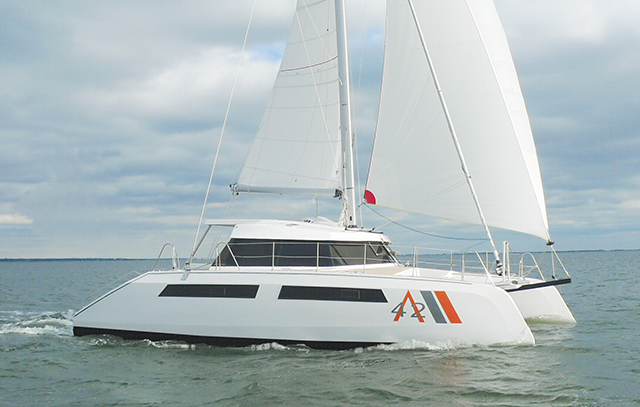Multihulls in America, an interview with the builder of the Alpha 42 (published April 2014)
You have built Aeroyacht into a dealer for many multihulls brands. How do you see your place in the U.S. multihull market?
Aeroyacht is now close to two decades old and I see the company as a boutique type of organization. To me, buying a boat is one of the most sensitive decisions you will have to make in your life. I like to see my company as a return to old school principles where clients can simply pick up the phone and talk to me, the owner and founder of Aeroyacht. My past collaboration with Wally Yachts (Aeroyacht 110 catamaran) and my involvement with and design of the Aeroyacht ALPHA 42 catamaran has differentiated our company into something a bit more exclusive than just a yacht sales dealership. Aeroyacht is a specialist multihull consultation company that sells 11 brands of new multihulls but also has an extensive list of international brokerage boats. We also have an in house design capability for special projects. We have acted as a publishing house for two major reference publications on catamarans and as production managers for special catamaran projects. New customers often think that Aeroyacht is a large company. Although my wife Flo has been very supportive and often helps out at boat shows, I work alone and even act as my own cleaning lady.
How did you come to create and build the new Alpha 42?
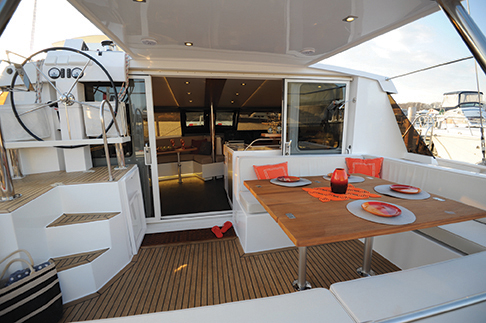 I wanted to design and build the ideal cruising catamaran for my family, something I could easily handle but would have enough room for the four of us. Flo is not a diehard sailor but likes the comfortable aspects of life aboard and spending time together as a family in beautiful locations. Marc Anassis, my partner and builder of the Alpha 42, approached me three years ago to help design a 35-foot cat that eventually turned into the Alpha 42. As the design matured we realized that the lower 40-foot range is also the “sweet spot” of the international charter market. Interestingly, the Lipari 41 catamaran, which our Alpha 42 compares to very closely, happens to be the most profitable charter boat in the industry. We developed the Alpha 42 to be a U.S.-built yacht for private use as well as for the charter market. It is a boat that will cater to experienced sailors stepping down from larger monohulls yet it is easy enough to handle for an older retired couple sailing around the world. The proof of the success of the boat is the customer profile of the eight existing boats sold. They range from experienced European sailors, to novice couples getting ready for a first time circumnavigation, to charter companies looking for a profitable and reliable workhorse.
I wanted to design and build the ideal cruising catamaran for my family, something I could easily handle but would have enough room for the four of us. Flo is not a diehard sailor but likes the comfortable aspects of life aboard and spending time together as a family in beautiful locations. Marc Anassis, my partner and builder of the Alpha 42, approached me three years ago to help design a 35-foot cat that eventually turned into the Alpha 42. As the design matured we realized that the lower 40-foot range is also the “sweet spot” of the international charter market. Interestingly, the Lipari 41 catamaran, which our Alpha 42 compares to very closely, happens to be the most profitable charter boat in the industry. We developed the Alpha 42 to be a U.S.-built yacht for private use as well as for the charter market. It is a boat that will cater to experienced sailors stepping down from larger monohulls yet it is easy enough to handle for an older retired couple sailing around the world. The proof of the success of the boat is the customer profile of the eight existing boats sold. They range from experienced European sailors, to novice couples getting ready for a first time circumnavigation, to charter companies looking for a profitable and reliable workhorse.
Tell us about the benefits of wave piercing bows.
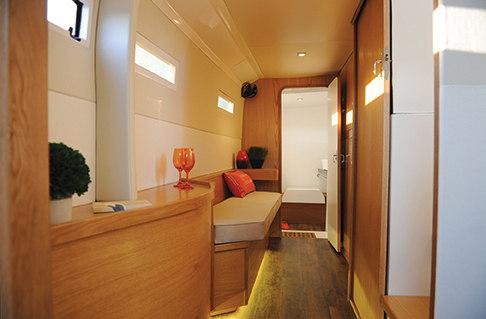 Wave piercing bows have been around since the Phoenicians. Builders seem to shy away from them as they seem difficult to build and may be considered too avant-garde. The bottom line is that wave piercing bows reduce pitching, the motion that robs the boat of forward momentum through drag and loss of hydrodynamic efficiency. Pitching increases hull resistance, reduces the efficiency of the rig and underwater foils due to unsteady air and water flow and causes motion discomfort for the people on the boat. In order to keep the boat from pitchpoling, you need a certain amount of buoyancy forward. On a wave-piercing type bow, this buoyancy and lift are achieved by making the hull fuller down low. On the Alpha 42, the hull is wider at the waterline than at the deck, especially near the bow. The wider, flatter underwater shape provides lift at high velocities and dampens pitching at all speeds. Other benefits of wave piercing bows are reduced weight and windage and a longer waterline length that increases speed. You can really feel this difference on medium displacement catamarans such as the Alpha 42. When sailing the boat in any sea state, the difference is noticeable. The bows act like shock absorbers and dampen the motion. In the North Atlantic arctic winter delivery of hull number one, the crew experienced 60 knot winds and 20-foot seas in truly horrifying conditions. The fact that our Alpha 42 has such a strong structure, extremely high 36-inch bridgedeck, and buoyant wave piercing bows greatly contributed to the crew’s confidence to lay ahull safely for nearly two days.
Wave piercing bows have been around since the Phoenicians. Builders seem to shy away from them as they seem difficult to build and may be considered too avant-garde. The bottom line is that wave piercing bows reduce pitching, the motion that robs the boat of forward momentum through drag and loss of hydrodynamic efficiency. Pitching increases hull resistance, reduces the efficiency of the rig and underwater foils due to unsteady air and water flow and causes motion discomfort for the people on the boat. In order to keep the boat from pitchpoling, you need a certain amount of buoyancy forward. On a wave-piercing type bow, this buoyancy and lift are achieved by making the hull fuller down low. On the Alpha 42, the hull is wider at the waterline than at the deck, especially near the bow. The wider, flatter underwater shape provides lift at high velocities and dampens pitching at all speeds. Other benefits of wave piercing bows are reduced weight and windage and a longer waterline length that increases speed. You can really feel this difference on medium displacement catamarans such as the Alpha 42. When sailing the boat in any sea state, the difference is noticeable. The bows act like shock absorbers and dampen the motion. In the North Atlantic arctic winter delivery of hull number one, the crew experienced 60 knot winds and 20-foot seas in truly horrifying conditions. The fact that our Alpha 42 has such a strong structure, extremely high 36-inch bridgedeck, and buoyant wave piercing bows greatly contributed to the crew’s confidence to lay ahull safely for nearly two days.
Although hull number one was intact it had to be abandoned last January 300 miles from shore due to a rogue wave. What happened ?
Being on a schedule is the most dangerous thing in sailing. The crew was lucky to be saved by the strength of the boat, which I was told at one point experienced 60 knots of wind and 20-foot seas. In the official insurance report, the captain writes that the rogue wave that hit them was much higher and broke squarely onto the yacht, driving the boat backwards. Of course no rudders in the world can withstand this. The owner’s words were: “At night we heard a big bang, a huge wave crashed onto our windows, which held, thank God, and the boat lurched backwards. I went outside and was surprised to see that the boat was still in one piece. We were always comfortable and safe.” Another experienced crew member had never laid ahull in a catamaran (and, quite honestly, I have not either) and the Alpha 42 apparently rode the waves very safely. The wave piercing bows worked perfectly, he said. No one seems to know why no beacon was left on the boat so it will be very difficult if not impossible to find it. It is very sad that nearly two years of hard work by our team has been left in the clutches of the icy North Atlantic, but I am glad that no one was hurt.
With hulls number two and three to be launched this summer, will you have boats for people to test sail?
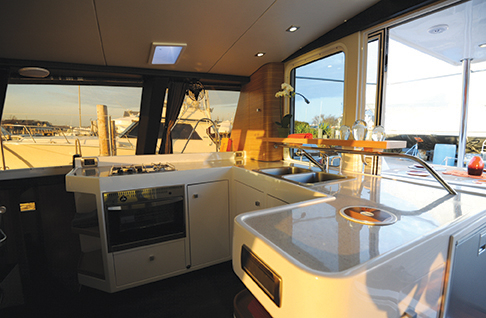
As with every new design, customers as well as the media need to get their hands on the product. Brochures and pretty pictures only go a certain way. They need to feel the boat, sail it and experience what different technologies Alpha Yachts are employing to build this machine. Hull number two will be available for test sails this summer. The benefit of being located one hour East of New York City makes our destination attractive for boat yard visits. We had a dozen couples fly in from all over the world to visit us during the build of number one. Hull number four, a boat that will be placed into the TMM charter fleet, will be available for charters by winter 2014/15 and she is scheduled to be shown at the Annapolis Boat Show this year. I believe, along with several industry experts, that the Alpha 42 will become a very popular and successful charter boat. We also offer a “Try Before You Buy Program” whereby customers have the opportunity to charter the Alpha 42 for as long as they want and if they decide to purchase an Alpha 42, they get their charter fee reimbursed by the yard.
You are building the Alpha 42 in the U.S. and still can offer it at a reasonable price. Can you tell us the benefits of building in this country?
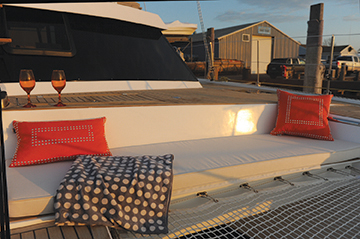
Without financing or outside help, we have put Alpha Yachts on the map and we hope to grow the company to be able to produce 10 to 15 catamarans per year. We Americans like to buy American. With the abundance of “Made in China” stickers on so many products, it probably feels refreshing to many customers that there is a small boutique company on Long Island building an honest cruising catamaran. What Tony Smith and Gemini, Dick Vermeulen and Maine Cat or Peter Johnstone with Gunboat have done has been very inspiring to me. They all cater to different markets but the idea is the same: create a quality boat that resonates with U.S. buyers as well as an international clientele. Most of our workers were hired from extinct boat builders who once built boats along the South Shore of Long Island. Patchogue, the town that Alpha Yachts has settled in, was once the boat building capital of New York State. More small work and pleasure boats were built here than in any other place on Long Island. In fact, the famous catboat originated from this town. It was an oyster workboat that later developed into a pleasure craft. Alpha Yachts was able to hire many craftsmen from this traditional industry. Most of our production is derived from molds. Since we do not use Aramid or exotic fibers, we can afford to hire relatively low cost labor to lay up the components so we remain competitive. We might not have the economies of scale and resulting buying power of the large French or South African builders, but by clever design and construction we can keep the price competitive. In addition, we do not have import duties or transatlantic delivery charges so in the U.S. our boats are on par with the competition. I think there is room for everyone in this growing market and we are only striving for a small market share that we hope to achieve. The press and the multihull community have all been very supportive and I am grateful for this.















